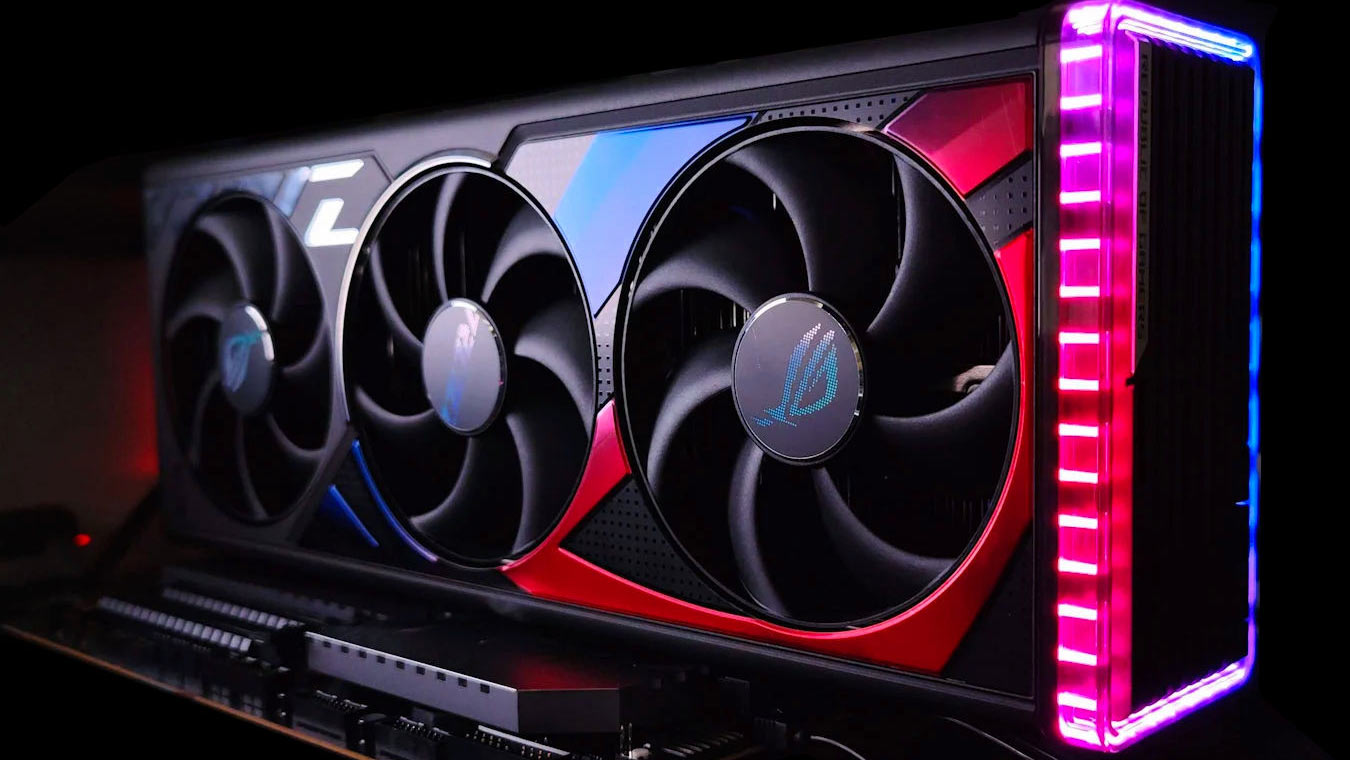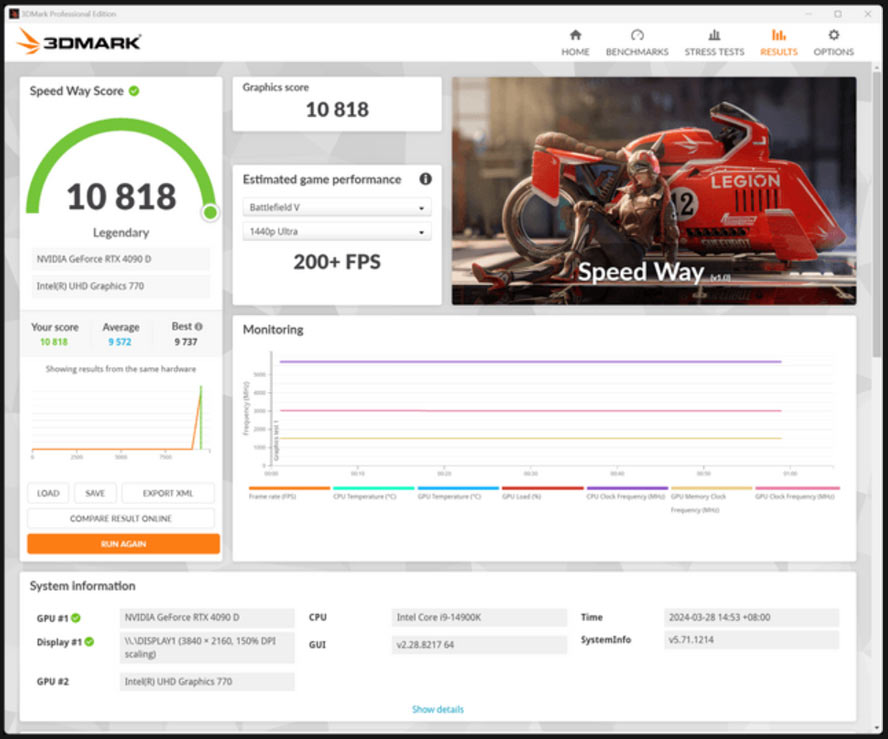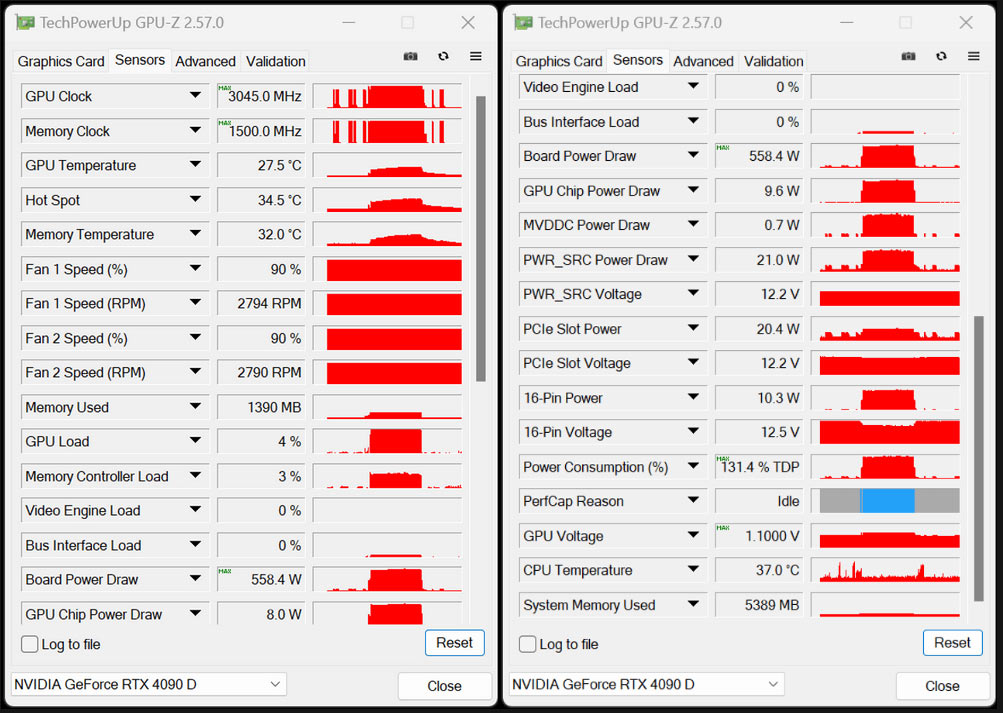Nvidia's sanctions-compliant 4090D gaming GPU for China is overclockable, restoring performance to standard unsanctioned RTX 4090 FE levels
Sanctions? What sanctions?

A Hong Kong-based PC technology and reviews site has shown that the sanctions-compliant Asus ROG Strix GeForce RTX 4090D graphics card can be overclocked to “achieve the performance level of the RTX 4090 FE.” HKEPC got one of Asus’ best graphics cards in the labs for testing and ran a multitude of synthetic and gaming benchmarks, pitting the RTX 4090D against a handful of its GeForce siblings, including the RTX 4090. It also had no trouble overclocking the US sanctions-compliant graphics card using GPU Tweak III, which then boosted performance to the level of a standard RTX 4090.
The RTX 4090D is a cut-down version of the top-end consumer graphics card from Nvidia, designed to limbo under specific performance metrics laid out by the US government. These sanctions are intended to deny China access to advanced chips that could be used to enhance its military prowess. The difference between the Nvidia GeForce RTX 4090 and RTX 4090D has been well documented in our previous articles, as have the reasons behind its existence. Here's the short overview of specs.
| Row 0 - Cell 0 | RTX 4090D | RTX 4090 |
| SMs | 114 | 128 |
| CUDA Cores | 14,592 | 16,384 |
| Tensor Cores | 456 | 512 |
| RT Cores | 114 | 128 |
| Boost Clock | 2,520MHz | 2,520MHz |
| Base Clock | 2,280MHz | 2,235MHz |
| VRAM Speed | 21Gbps | 21Gbps |
| VRAM Capacity | 24GB GDDR6X | 24GB GDDR6X |
| VRAM Bus Width | 384-bit | 384-bit |
| VRAM Bandwidth | 1,008GB/s | 1,008GB/s |
| L2 Cache | 72MB | 72MB |
| ROPs | 176 | 176 |
| TMUs | 456 | 512 |
| TGP | 425W | 450W |
| Total Processing Power | 4707 | 5285 |
To make a sanctions-compliant version of the GeForce RTX 4090, there was really only one key spec that was cut. The AD102 die common to the RTX 4090 and 4090D has a maximum of 144 SMs (Streaming Multiprocessors), each with four tensor cores that are capable of up to 256 16-bit floating-point operations per cycle. The standard RTX 4090 has 128 SMs enabled, while the RTX 4090D drops that number to 114. The 4090D also drops the TGP (Total Graphics Power) to 425W instead of 450W.
If you do that math, the reduction in SMs — which also reduces the number of Tensor cores, CUDA cores, and RT cores — results in a "sanctions-compliant" model for the Chinese market. The RTX 4090 has a TPP (Total Processing Power) rating of 5,285, while the RTX 4090 skirts just under the 4,800 sanctions-imposed limit and lands at 4,707.
It should be noted that the TPP limit in general isn't particularly useful, as it depends on raw specs. In our testing of the RTX 4090 Founders Edition, we found average GPU clocks ranged from 2,736 MHz at 4K ultra settings, up to 2,762 MHz at 1080p. That yields a "real-world" TPP of 5,738 — 8.6% higher than the paper spec would suggest.
We've seen other reviews of the RTX 4090D that suggest the Chinese market GPU is only about 5% slower in gaming, and 10% slower in AI workloads (Galax model) than the full-fat RTX 4090. That's as designed, though of course coming in at 4,707 rather than 5,285 TPP hardly matters — you'd just need 12% more GPUs to make up the difference. But that's only if you're using the stock clocks.
HKEPC looked at the Asus ROG Strix GeForce RTX 4090D, and notes that the card is “exactly the same” as the sanctioned RTX 4090 version, except for the cut-down AD102-250 GPU core being used. That means it has great cooling and an advanced power delivery system. It also means it can be overclocked.
HKEPC conducted extensive synthetic and gaming tests with the RTX 4090D at stock settings, making up most of the HKEPC article. The Asus performed as expected here, nestling between the RTX 4080 and RTX 4090, but generally landing closer to the flagship.
Overclocking the ROG Strix GeForce RTX 4090D
HKEPC also observed that the ROG Strix RTX 4090D version “has lifted the restriction of not being able to overclock, and the TGP power consumption can be liberated.” Apologies for that machine translation, but it also specifically mentions that Asus GPU Tweak III could lift the power limit to a maximum of 600W. Its best overclocking tweaks ended up being a GPU Clock of +200 MHz, Mem Clock of +187 MHz, and the card consumed up to 558.4W with these settings.
The outcome was that HKEPC successfully boosted the Speedway benchmark scores from 9,894 to 10,818, representing a 9.3% uplift. Testing in 3DMark Port Royale delivered a similar story, with an uplift of 8.7%.



In its conclusion, HKEPC told readers that while Nvidia doesn’t allow AIBs to sell OC cards, it doesn’t restrict users from DIY overclocking shenanigans. “After a high degree of overclocking adjustment, the ROG Strix RTX 4090D actually has a way to achieve the performance level of the RTX 4090 FE,” it asserted. HKEPC reckon that the low-hype RTX 4090D is a pretty good deal but worry that when the RTX 50-series arrives, China residents won’t even be able to buy the 80-class card, never mind the 90-class.
The Nvidia B200 Blackwell will also land far beyond the sanctions limit of 4,800 TPP, incidentally. While Nvidia hasn't given all the raw specs, a single B200 GPU will provide 2.25 petaflops of dense FP16 throughput. That gives a Total Processing Power rating of 36,000, or 7.5X the current sanctions-imposed limit. Even if the consumer GB202, GB203, etc. 'only' offer 50% more compute than the current Nvidia Ada Lovelace GPUs, that would potentially put a future RTX 4080 right near the limit. We'll find out more about Nvidia Blackwell later this year.
Get Tom's Hardware's best news and in-depth reviews, straight to your inbox.

Mark Tyson is a news editor at Tom's Hardware. He enjoys covering the full breadth of PC tech; from business and semiconductor design to products approaching the edge of reason.
-
Notton "Sanctions have backfired."Reply
I don't think "backfired" is the word you are looking for. That would imply that it has the reverse of the intended effect. It would mean the 4090D performs better than the 4090 after overclocking, which it doesn't.
"Circumvention" would be a better fit. -
35below0 Not mentioned in the headline:Reply
- die is cut down
- power consumption exceedes 550W
I also wonder how stable the D is compared to the real thing. In addition, sanctions will be revisited again. This exception may be just one more loophole to close.
"good enough for government work" seems to apply to all three sides here, US, PRC, and nvidia -
vanadiel007 One thing to remember is that making chips specifically to comply with sanctions, will mean increased pricing for other markets that do not have sanctions.Reply
It just does not work for technology the way it works for manufacturing. We the consumer will just keep paying higher and higher prices.
If you want proof of that, just go buy something electronic and compare the price for the same product to 5 years ago. Much higher price than just adjustment for inflation and R&D research. -
jlake3 Isn't the goal of sanctions to drive up the cost and decrease the density of HPC performance, to make things like supercomputing for nuclear weapons simulation or development of autonomous weapons more difficult?Reply
A gamer being able to buy one card and overclock it to match the banned flagship but at a 25% higher power draw than rated TDP doesn't mean sanctions have failed. An AI researcher being able to back-channel import 4-8 cards for their workstation doesn't mean sanctions have failed. -
JarredWaltonGPU Reply
I've tweaked the article (which was written while I was sleeping). Backfire certainly isn't the right word for the 4090D situation, and the reality is that the arbitrarily imposed sanctions limit of 4800 TPP was always basically meaningless. The 4090D has a TPP of 4707 on paper, but what clocks does it achieve in practice?Notton said:"Sanctions have backfired."
I don't think "backfired" is the word you are looking for. That would imply that it has the reverse of the intended effect. It would mean the 4090D performs better than the 4090 after overclocking, which it doesn't.
"Circumvention" would be a better fit.
Our testing of the 4090 shows real-world clocks of 2.7 GHz and above. If the 4090D can hit similar clocks at stock, that would mean its actual TPP would increase to over 5000. Even if it were completely locked down (too late for that, most likely!), does a card that only runs at 4707 TPP actually prevent it from being used in the same way as a card that offers 5285 TPP? Worst-case, China would need 12% more 4090D cards to match the compute of 4090 cards.
It's all shenanigans. Anyone with half a brain already knew that restrictions on the RTX 4090 in China at this stage were far too late to accomplish anything. Plenty of the cards were sold in China before the sanctions came out, and even more were sold right as wind of the upcoming sanctions started blowing through the interwebs. Blocking all sales of H100 in China before those happened was what was needed, and even that would have likely been insufficient.
What will be more interesting to see is how these sanctions impact future Blackwell GPUs. Obviously the RTX 5090 will be much faster than the 4090, so much faster than it's unlikely that any GB202 based card will ever be allowed to be sold (directly) in China. But I have no doubt China will still get its hands on such cards. Will GB203 also be subject to sanctions? Very possibly.
Blackwell B200 has no chance of being allowed for direct sales. It's 7.5X the allowed limit, based on initial specs, so China will need to continue to make do with the H20 from Nvidia (or work around the sanctions through back channels). And so China will also continue to work very hard to make its own hardware that will exceed what it can import. Ten years from now it will probably catch up to Intel, AMD, Nvidia, etc. and the sanctions will not matter. And that's when the sanctions will have truly backfired. -
Co BIY ReplyJarredWaltonGPU said:. And so China will also continue to work very hard to make its own hardware that will exceed what it can import. Ten years from now it will probably catch up to Intel, AMD, Nvidia, etc. and the sanctions will not matter. And that's when the sanctions will have truly backfired.
If China has to work very hard to overcome the current sanctions, put in place as a punishment for their current behavior, then they may have been effective as sanctions, a punishment.
The goal is to demonstrate that China cannot flout the standards of the international order and expect to be allowed all the benefits of fully participating in that order. The overarching goal of the sanctions is not technological.
They will have backfired if Chinese behavior internationally becomes worse out of anger, fear, perceived isolation, or CCP leadership paranoia aggravated by the sanctions. This is why they are so specific and targeted, designed to not effect a large number of people. -
JarredWaltonGPU Reply
If China doesn't change its behavior, and then proceeds to work around sanctions to the point where the sanctions are meaningless, and this ultimately leads to the sanctions hurting the US instead, that's backfiring. It's the law of unintended consequences. You want one thing to happen and instead something undesirable happens instead. You point a gun and pull the trigger, and instead of a bullet shooting at your intended target, it blows up in your face.Co BIY said:If China has to work very hard to overcome the current sanctions, put in place as a punishment for their current behavior, then they may have been effective as sanctions, a punishment.
The U.S. (and others) want China to behave "better," and are trying to force the issue via sanctions. Lack of change inherently means the sanctions aren't working — China doesn't have to get worse for the sanctions to have failed, it just needs to continue on its current path. Right now, it's doubling down and resisting change by trying to do things on its own.
And if the sanctions don't work and China eventually reaches the point where it threaten the US and its allies economically, politically, socially, militarily, whatever, that's backfiring. That's what I'm saying, and in essence you've agreed.
China continues to flout "international standards," and with 1.4 billion people, it could reach the point where it eventually just gets to define what those standards should be. "China wins." How would that not be backfiring? The US is trying to send China to "timeout," and it looks like China will get angrier and more stubborn and resistant to US influence. Oops.
I don't even think the US really cares about stopping China, though. What it really wants is short term concessions, and as with the sanctions, the long term impact is harder to nail down and becomes Somebody Else's Problem. We're just trying to erect an SEP field around China for now so we can all go on our merry way. (That's a Hitchhiker's Guide to the Galaxy reference, if you didn't get it.) :) -
LabRat 891 Uh. Duh...Reply
(This is probably tangentially related to AMD's GRE getting VRAM OCing unlocked, too. ) -
vbevan Reply
I think it's the opposite?jlake3 said:Isn't the goal of sanctions to drive up the cost and decrease the density of HPC performance, to make things like supercomputing for nuclear weapons simulation or development of autonomous weapons more difficult?
A gamer being able to buy one card and overclock it to match the banned flagship but at a 25% higher power draw than rated TDP doesn't mean sanctions have failed. An AI researcher being able to back-channel import 4-8 cards for their workstation doesn't mean sanctions have failed.
Sanctions will have zero effect on state actors getting vanilla 4090s, either through international markets or neighboring states.
What it will do is hurt the hobbyist AI researcher. That is where the next generation of AI workers sits, it's actually pretty clever if you think of it that way.
People who say they can just overclock aren't thinking about the problems stability issues will cause. Corrupted frames or even having to reboot is annoying when playing games. When training a model, which can take days to complete, a crash means starting again. -
Pierce2623 Reply
“Backfired” is still in the secondary title section and it’s just not really the right word considering Nvidia just totally flaunted the regulations by allowing overclock support.JarredWaltonGPU said:I've tweaked the article (which was written while I was sleeping). Backfire certainly isn't the right word for the 4090D situation, and the reality is that the arbitrarily imposed sanctions limit of 4800 TPP was always basically meaningless. The 4090D has a TPP of 4707 on paper, but what clocks does it achieve in practice?
Our testing of the 4090 shows real-world clocks of 2.7 GHz and above. If the 4090D can hit similar clocks at stock, that would mean its actual TPP would increase to over 5000. Even if it were completely locked down (too late for that, most likely!), does a card that only runs at 4707 TPP actually prevent it from being used in the same way as a card that offers 5285 TPP? Worst-case, China would need 12% more 4090D cards to match the compute of 4090 cards.
It's all shenanigans. Anyone with half a brain already knew that restrictions on the RTX 4090 in China at this stage were far too late to accomplish anything. Plenty of the cards were sold in China before the sanctions came out, and even more were sold right as wind of the upcoming sanctions started blowing through the interwebs. Blocking all sales of H100 in China before those happened was what was needed, and even that would have likely been insufficient.
What will be more interesting to see is how these sanctions impact future Blackwell GPUs. Obviously the RTX 5090 will be much faster than the 4090, so much faster than it's unlikely that any GB202 based card will ever be allowed to be sold (directly) in China. But I have no doubt China will still get its hands on such cards. Will GB203 also be subject to sanctions? Very possibly.
Blackwell B200 has no chance of being allowed for direct sales. It's 7.5X the allowed limit, based on initial specs, so China will need to continue to make do with the H20 from Nvidia (or work around the sanctions through back channels). And so China will also continue to work very hard to make its own hardware that will exceed what it can import. Ten years from now it will probably catch up to Intel, AMD, Nvidia, etc. and the sanctions will not matter. And that's when the sanctions will have truly backfired.